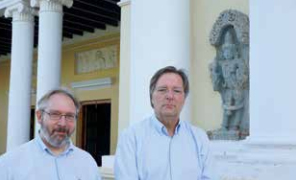
Centre of Jaina Studies Newsletter: SOAS - University of London
The religious, literary, and scientific exchanges between the Perso-Arabic and Indian cultural spheres during the medieval period are of vital importance for understanding the intellectual history of Asiaand, by extension, of Europe, which became the recipient of Arabized scholarship during and following the Islamic Golden Age. Nevertheless, comparatively little research has been done in this field, nearly all of it focussing on the Perso-Arabic reception of Indian (predominantly Hindu) traditions of knowledge. The purpose of this ongoing research project, funded by the Riksbankend Jubileumsfond, is to examine the flow of ideas in the opposite direction, that is, Hindu reception of PersoArabic knowledge systems, from the 13th to the 16th centuries.
The Perso-Arabic reception of Indian knowledge systems, the focus of the current international research project Perso-Indica, spans a number of disciplines including religion, philosophy, mathematics and natural science. By contrast, the Hindu reception of PersoArabic learning is concentrated to a few areas of central importance. These include Islamic adaptations of Galenic medicine, known as yūnānī; but above all, the reception is dominated by jyotiḥśāstra or astronomical-astrological disciplines. The transmission of these disciplines is of fundamental importance for the history of religion. The divinatory system and metaphysical presuppositions of horoscopic astrology, springing partly from Mesopotamian astral religion, partly from the syncretic milieu of the Hellenistic era, became deeply embedded in Hinduism after reaching India from the Greek-speaking world in the early centuries CE, supplanting indigenous forms of astral divination dating back at least to the beginning of the first millennium BCE. In pre-Islamic Persia, astrological beliefs similarly formed essential parts of Manichaean as well as Zoroastrian religion. Following the Muslim invasion, Persian astrology was modified to conform to Islam; and it was in this Arabized form that it reached India and was once again adapted to a new religious framework.
At some point between the tenth and thirteenth century, roughly contemporaneously with the arrival of Arabic-language astrology in Christian Europe via al-' Andalūs, the established Hindu astral disciplines were thus challenged by the formulation of this independent school, known as tājika-śāstra or 'the Persian teaching' and comprising a Sanskritization of Perso-Arabic traditions. Despite the initial censure of Brahmans who found its extra-Indian origins unacceptable on grounds of religious purity, the Tājika system still survives in India today, particularly in the northern parts of the subcontinent.
To a large extent, this transmission of Perso-Arabic knowledge systems influenced by Islam to the Sanskritlanguage cultural sphere was accomplished by the mediation of Jaina scholars. Trade routes between the Persian Gulf and Arabian Peninsula on one hand and northwestern India on the otherin particular, the Saurāṣṭra area of present-day Gujaratwere well established long before the time of the Delhi Sultanate; and a prominent part in these contacts was played by Jaina merchants, who dominated the areas of finance and coinage in the region. Influential Jaina families were thus the natural allies of the Sultanate in financial and administrative matters, and, by extension, Jaina intellectuals became intermediaries between Perso-Arabic and Sanskritic traditions of knowledge. By this mediation of 'familiar strangers', Islamic astronomy-astrology was made accessible to the Brahmanic intellectual majority. The perhaps earliest preserved Sanskrit work on tājika-śāstra, the Trailokyaprakāśa, is said to have been authored by Jaina scholar Hemaprabhasūri in 1248; and in 1370, around the time when Geoffrey Chaucer wrote his Treatise on the Astrolabe in the English vernacular, Mahendrasūrianother Jainacomposed the first Sanskrit manual (the Yantrarājāgama) on this sophisticated astronomical instrument introduced into India by Muslim astronomer-astrologers.
The current project thus consists of two mutually dependent lines of research: on the one hand, the broader issues of Jaina perceptions of Islamic culture and mediation between Islamicized and Hindu systems of knowledge; and on the other, the more specialized enquiry into the Hindu reception of Perso-Arabic astral knowledge traditions (tājika-śāstra). For the latter, a major focal point is the encyclopaedic work Hāyanaratna, composed at the court of Shāh Shujā' at Agra in 1629 by his Brahman court astrologer Balabhadra; for the former, the fourteenth-century work Nābhinandanajinoddhāraprabandha by Kakkasūri, depicting the interaction between the Muslim regime and local Jaina merchants, is proving a particularly fruitful source text. The research so far indicates that the Prāgvaṭa community (known today as Porwad, a mixed Jaina-Hindu group) played a major part in the early transmission process.

Martin Gansten and Olle Qvarnström of Lund University outside the Oriental Research Institute in Mysore, where they were looking for additional source material. Photo: Anna Gansten
 Prof. Olle Qvarnström
Prof. Olle Qvarnström